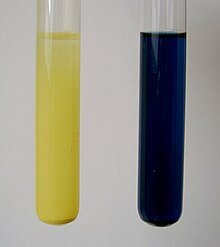Ammonium heptamolybdate
| Crystal structure | |||||||||||||||||||
|---|---|---|---|---|---|---|---|---|---|---|---|---|---|---|---|---|---|---|---|

|
|||||||||||||||||||
|
__ Mo 6+ __ O 2− The heptamolybdate anion in ammonium heptamolybdate |
|||||||||||||||||||
| General | |||||||||||||||||||
| Surname | Ammonium heptamolybdate | ||||||||||||||||||
| Ratio formula | (NH 4 ) 6 Mo 7 O 24 | ||||||||||||||||||
| Brief description |
colorless crystals |
||||||||||||||||||
| External identifiers / databases | |||||||||||||||||||
|
|||||||||||||||||||
| properties | |||||||||||||||||||
| Molar mass | 1235.86 g mol −1 (tetrahydrate) | ||||||||||||||||||
| Physical state |
firmly |
||||||||||||||||||
| density |
2.498 g cm −3 |
||||||||||||||||||
| Melting point |
90 ° C (decomp.) |
||||||||||||||||||
| solubility |
|
||||||||||||||||||
| safety instructions | |||||||||||||||||||
|
|||||||||||||||||||
| Toxicological data | |||||||||||||||||||
| As far as possible and customary, SI units are used. Unless otherwise noted, the data given apply to standard conditions . | |||||||||||||||||||
Ammonium heptamolybdate forms colorless crystals which decompose at around 90 ° C, giving off water of crystallization. It usually forms a tetrahydrate with the chemical formula (NH 4 ) 6 Mo 7 O 24 · 4 H 2 O. It is often referred to just as ammonium molybdate , although ammonium molybdate may as well refer to ammonium orthomolybdate (NH 4 ) 2 MoO 4 and other molybdates.
presentation
Ammonium heptamolybdate is made quite simply by dissolving molybdenum (VI) oxide in an excess of aqueous ammonia and then evaporating the solution at room temperature. As the solution evaporates, the excess ammonia escapes. This method leads to the formation of six-sided transparent prisms of the tetrahydrate of ammonium heptamolybdate. Solutions of ammonium heptamolybdate react with acids again to form molybdenum (VI) oxide and the corresponding ammonium salts. The pH of a concentrated solution is between 5 and 6.
use
Ammonium heptamolybdate is used in the laboratory for the detection of silicic acids , phosphoric acid , phosphates , arsenic , lead and sorbitol as well as for the analysis of sea water . In addition, it is used in a standardized procedure for measuring the emission of hydrogen sulfide .
With phosphates, after previous treatment of the material sample with nitric acid , it forms a yellowish precipitate of molybdenum yellow / ammonium dodecamolybdate phosphate (NH 4 ) 3 [P (Mo 3 O 10 ) 4 ]. If ascorbic acid is added as a mild reducing agent, it turns a strong blue color (formation of molybdenum blue ). At lower concentrations of molybdate there is no precipitation, only a change in color of the solution.
Taking into account that the heptamolybdate enters into an equilibrium in aqueous solution:
the following reaction equation results:
These reactions are also used for the photometric determination of molybdate or phosphate in the trace range.
It is also used in the production of catalysts , as a molybdenum fertilizer and, on an industrial scale, as an intermediate product for extracting molybdenum from molybdenum ores.
In biology and biochemistry it is also used in electron microscopy as a contrast medium ( negative print ) in a concentration of 3 to 5% by volume, even if trehalose is present in the sample. It is also used in cryo-electron microscopy - in saturated concentrations - as a contrast medium.
Individual evidence
- ↑ a b c d e David R. Lide (Ed.): CRC Handbook of Chemistry and Physics . 90th edition. (Internet version: 2010), CRC Press / Taylor and Francis, Boca Raton, FL, Properties of the Elements and Inorganic Compounds, pp. 4-47.
- ↑ a b data sheet ammonium heptamolybdate (PDF) from Carl Roth , accessed on August 20, 2010.
- ↑ a b Entry on ammonium molybdate in the GESTIS substance database of the IFA , accessed on July 23, 2016(JavaScript required) .
- ↑ Data sheet ammonium heptamolybdate tetrahydrate ( Memento from May 9, 2011 in the Internet Archive ) at GFS Chemicals (PDF; 44 kB).
- ↑ L. Svanberg, H. Struve: About some compounds and about the atomic weight of molybdenum . In: Journal for Practical Chemistry . tape 44 , 1848, pp. 257-321 , here: p. 282 ( full text - quoted in Gmelin's Handbuch für Anorganische Chemie. Volume 53, p. 255).
- ^ Chemicals.de
- ↑ T. Parsons, V. Maita, C. Lalli: A manual of chemical and biological methods for seawater analysis , Pergamon, Oxford 1984.
- ↑ VDI 2454 sheet 1: 1982-03 measurement of gaseous immissions; Measuring hydrogen sulfide concentration; Molybdenum blue sorption process. VDI-Verlag, Düsseldorf, pp. 2-3.
- ↑ Pictures at Seilnacht
- ↑ Overview ( Memento from February 28, 2013 in the Internet Archive ) (PDF; 252 kB)
- ↑ Report on Molybdenum from Science Online
- ↑ JR Harris, RW Horne: Negative staining , in: JR Harris (Ed.), Electron Microscopy in Biology, Oxford University Press, Oxford 1991.
- ↑ M. Adrian, J. Dubochet, SD Fuller, JR Harris: Cryo-negative staining , in: Micron , 1998 , 29 (2-3), pp. 145-160; doi : 10.1016 / S0968-4328 (97) 00068-1 .
- ^ S. De Carlo, C. El-Bez, C. Alvarez-Rúa, J. Borge, J. Dubochet: Cryo-negative staining reduces electron-beam sensitivity of vitrified biological particles , in: J. Struct. Biol. , 2002 , 138 (3), pp. 216-226; doi : 10.1016 / S1047-8477 (02) 00035-7 ; PMID 12217660 .
Web links
- climaxem.com: Preparation of molybdate solutions ( Memento from March 1, 2012 in the Internet Archive )



![\ mathrm {\ PO_4 ^ {3-} + 12 \ MoO_4 ^ {2-} + 24 \ H ^ + + 3 \ NH_4 ^ + \ longrightarrow (NH_4) _3 [P (Mo_3O_ {10}) _ 4] + 12 \ H_2O}](https://wikimedia.org/api/rest_v1/media/math/render/svg/87f15831b5616a4f4ae3274bfe97f6257ca1b693)